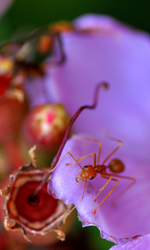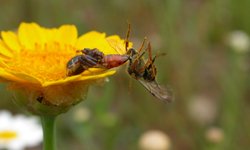Back to Projects

Like other animals, pollinators must obtain resources and stay alive to maximise their reproductive success. Their foraging rules, therefore, should not be based solely on the distribution of resources: predation risk should also play a role on where and when pollinators forage.
Other than developing some theoretical models, we have worked with two experimental systems, using crab spiders (Thomisidae) and weaver ants (Oecophylla smaragdina) as predators. Many species of crab spiders and weaver ants make extensive use of flowers as hunting platforms. They ambush on or under flowers to attack unsuspecting visitors. Indeed, several genera within the Thomisidae have specialised on hunting from flowers.

Crab spiders can have strong effects on pollinator behaviour, but are unlikely to affect plant communities due to their relative scarcity. Although they are famous for their cryptic colours (some species can adapt their colour to the colour of the flowers on which they ambush pollinators), there is little evidence that crypsis has evolved for its effect on pollinator behaviour. We guess that cryptic spiders are more likely to avoid being detected by their predators – but such a guess remains to be tested.
Weaver ants, due to their abundance and mobility, can impose strong selective pressures both on pollinators and plants, and their presence can alter the structure of pollination networks. The effect of weaver ants on their host plants depends on the size of the plant’s pollinators.Thus, while many flowers produce ant-deterring substances – presumably to prevent ants from scaring pollinators away--, the flowers of Melastoma malabathricum attract weaver ants. M. malabathricum flowers are pollinated mainly by large carpenter bees, which are not scared by the presence of ants (see video). What is more, carpenter bees preferentially forage on ant-harbouring plants, where competition for resources is low because small pollen thieves are scared away by ants (see video).

Related publications